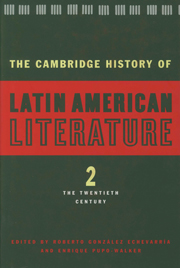Book contents
- Frontmatter
- Introduction to Volume 2
- 1 Modernist poetry
- 2 Modernist prose
- 3 The Vanguardia and its implications
- 4 The literature of Indigenismo
- 5 Afro-Hispanic American literature
- 6 The Criollista novel
- 7 The novel of the Mexican Revolution
- 8 The Spanish American novel from 1950 to 1975
- 9 The Spanish American novel: recent developments, 1975 to 1990
- 10 Spanish American poetry from 1922 to 1975
- 11 The modern essay in Spanish America
- 12 Literary criticism in Spanish America
- 13 The autobiographical narrative
- 14 The twentieth-century short story in Spanish America
- 15 Spanish American theatre in the twentieth century
- 16 Latin American (Hispanic Caribbean) literature written in the United States
- 17 Chicano literature
- Index
- Bibliographies
- References
7 - The novel of the Mexican Revolution
Published online by Cambridge University Press: 28 March 2008
- Frontmatter
- Introduction to Volume 2
- 1 Modernist poetry
- 2 Modernist prose
- 3 The Vanguardia and its implications
- 4 The literature of Indigenismo
- 5 Afro-Hispanic American literature
- 6 The Criollista novel
- 7 The novel of the Mexican Revolution
- 8 The Spanish American novel from 1950 to 1975
- 9 The Spanish American novel: recent developments, 1975 to 1990
- 10 Spanish American poetry from 1922 to 1975
- 11 The modern essay in Spanish America
- 12 Literary criticism in Spanish America
- 13 The autobiographical narrative
- 14 The twentieth-century short story in Spanish America
- 15 Spanish American theatre in the twentieth century
- 16 Latin American (Hispanic Caribbean) literature written in the United States
- 17 Chicano literature
- Index
- Bibliographies
- References
Summary
The Mexican Revolution was one of the last old-fashioned, pre-industrial wars, in which modern techniques and machinery had only an occasional role to play. It was a war of epic battles and mythical warrior-heroes, two of whom - Pancho Villa and Emiliano Zapata - have achieved fame throughout the world. And since it was a war in which people were more important than machines, it provided a generation of Mexican novelists with an abundant source of inspiration and material.
It began in November 1910. The president, Porfirio Díaz (1830-1915), had ruled, in person or by proxy, since 1876, retaining power for so long by imposing a right-wing dictatorship on a country which, despite some industrialization, retained social and economic structures based on the quasi-feudal system of the hacienda. For some years before 1910 a brave and idealistic northern liberal, Franciso I. Madero (1873-1913), had been campaigning for a revision of the political system and the establishment of a democracy based on the principles of universal suffrage and no presidential re-election. Seeing that his peaceful campaign was achieving nothing, for in fraudulent presidential elections in July 1910 Diaz was reelected yet again, Madero called for an uprising against the dictator on November 20.
It seemed a hopeless cause. However, Díaz was a tired old man, and his government and his generals had grown old with him. The federal army was incapable of quashing this minor revolt, which gathered support as the months went by. In May 1911 the rebels won their first serious battle, capturing the northern frontier town of Ciudad Ju´rez.
- Type
- Chapter
- Information
- The Cambridge History of Latin American Literature , pp. 213 - 225Publisher: Cambridge University PressPrint publication year: 1996
References
- 1
- Cited by

